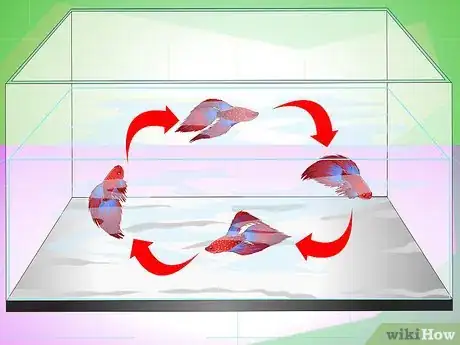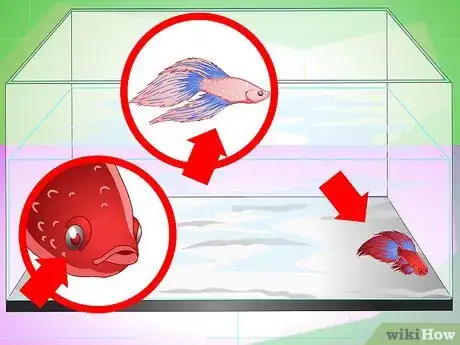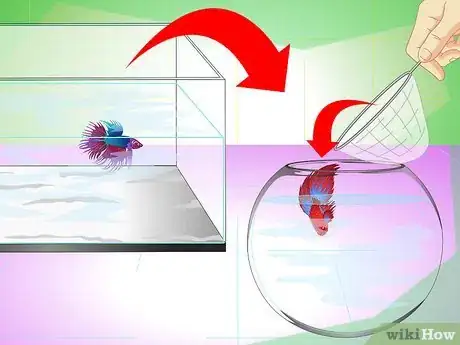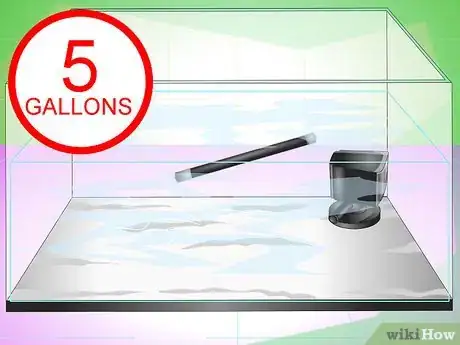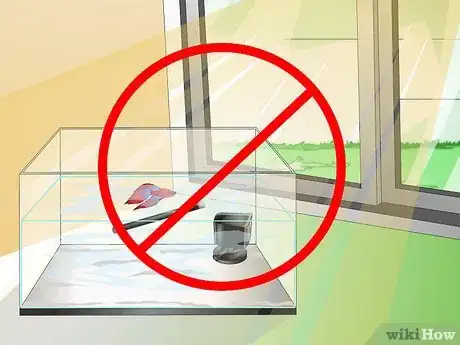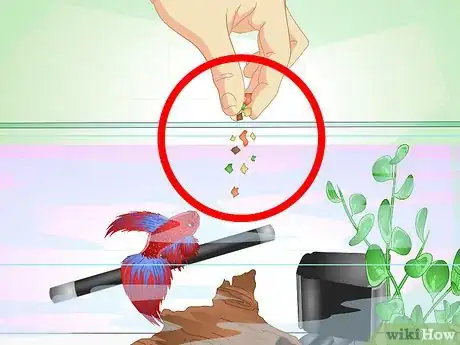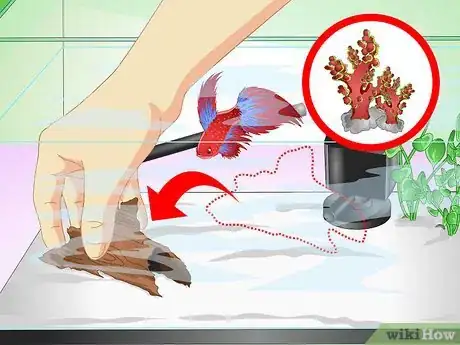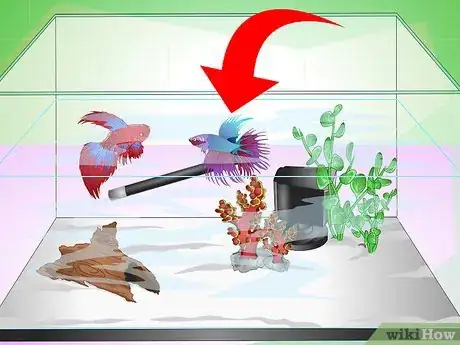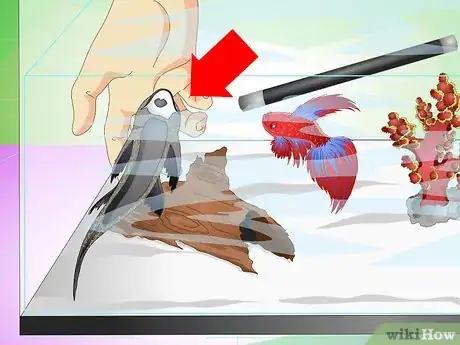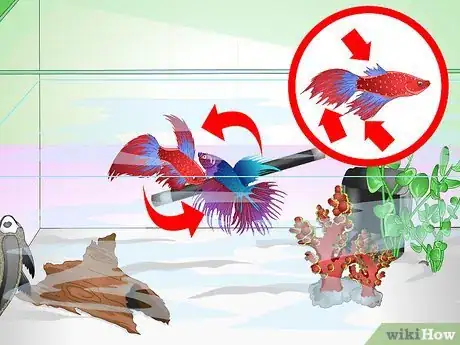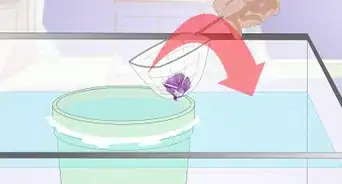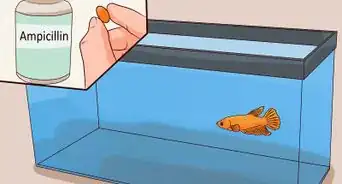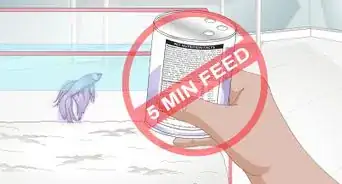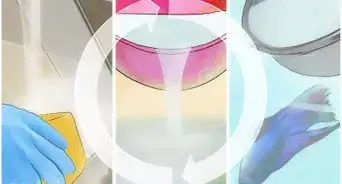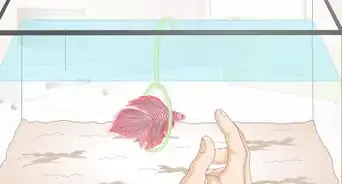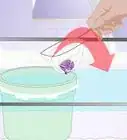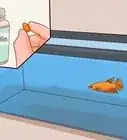This article was co-authored by Pippa Elliott, MRCVS. Dr. Elliott, BVMS, MRCVS is a veterinarian with over 30 years of experience in veterinary surgery and companion animal practice. She graduated from the University of Glasgow in 1987 with a degree in veterinary medicine and surgery. She has worked at the same animal clinic in her hometown for over 20 years.
There are 10 references cited in this article, which can be found at the bottom of the page.
wikiHow marks an article as reader-approved once it receives enough positive feedback. This article received 16 testimonials and 91% of readers who voted found it helpful, earning it our reader-approved status.
This article has been viewed 261,587 times.
Does your betta fish look sad? Is he often resting at the bottom of his tank? Your fish might be bored or even sick. It is a popular belief that betta fish need little to no care, but this is not true. Here are some ways you can help keep your betta fish happy and healthy.
Steps
Watching For Signs Of Illness
-
1Know what a healthy betta looks and acts like. A healthy betta eats vigorously, swims around and is active, is colorful and vibrant, has fins and a tail that spread out like fans, and has scales and a body that look slick and clean.
-
2Know what a sick betta looks and acts like. Sometimes, a betta acts sad because he is sick. If your betta is lethargic, check the tank's temperature and test the water. You may need to do a water change or turn up the heater. Signs of a sick betta are: [1]
- Does not eat at all or eats reluctantly
- Is inactive; stays in a corner of the tank, lays at the bottom, or is always at the surface
- Purposely runs into objects, as if in an effort to scratch itself
- Looks pale, grey, or generally dull in color
- Tail and/or fins are clumped, closed, stiff looking, or falling apart
- Body has open sores, white cottony patches, red spots or white spots, or lumps
- Eyes are excessively protruding or swollen looking
- Gills don’t close all the way and stay half-open; they may look swollen or red
- Scales are raised like a pine cone
- Belly looks either hollow or extended and swollen
Advertisement -
3Diagnose your betta’s illness. There are several common betta illnesses that can be treated if diagnosed correctly, but you should be sure about what your fish has before starting treatment. Some medicines work for several different types of fish illnesses, but you should be sure to get the correct one. Some common fish illnesses are:
- Fungal infection: look for white cottony patches on body and head, closed up fins, pale color, less activity
- Tail and/or fin rot: look for fin and tail getting shorter, falling apart, having a darker color, less activity, and reluctant eating
- Ick: look for small white spots (like the body was sprinkled with salt), less activity and eating, and attempted scratching against rocks or plants
- Velvet: look for less activity, loss of appetite and color. Velvet (a parasite) can be hard to spot so use a flashlight and look for a fine gold or rusty mist on the fish’s body
- Dropsy: look for a big, extended belly and scales that are raised and look like pine cones. Unfortunately, this is one disease for which there is no known treatment; it is thought to be a bacteria that causes kidney failure and may be linked to feeding live worms to a betta.
-
4Isolate your sick betta for treatment. If you keep other fish or water animals (snails or frogs) with your betta as companions, you’ll need to remove your betta from the communal tank to treat it. You don’t want to treat healthy fish or water animals if they aren’t sick, though a complete water change for the whole tank is a good idea if you have one sick fish. Your sick betta may need to be isolated for up to 3-4 weeks while it gets better. Go to your nearest pet store and look for medicines that treat the various illnesses listed above; they will all most likely contain types of antibiotics (tetracycline, ampicillin) or antifungals (maracin).
-
5Speak to the pet store aquarium specialist or to a veterinarian. Do this if your fish seems sick and you cannot determine what is wrong, especially BEFORE beginning treatment. It is not a good idea to treat your betta with the wrong medicines because this could make him sicker.[2]
Creating A Nice Home For Your Betta
-
1Choose a good home for your betta. Bettas need a tank that holds a minimum of 5 gallons (18.9 L). Bettas also need a heater, as they are tropical fish that prefer temperatures from 76–84 °F (24.4–28.9 °C), and a filter. Be sure to have cycled the filter, too.[3]
- Be sure to always check that your heater is working properly because a heater that makes the water too hot for your fish (over 82 degrees Fahrenheit) is also bad for the fish and can harm him.
- A filter is necessary. For smaller tanks, get a special low-current one. A regular filter in a small tank may create too much current for the fish. Gentle sponge filters are the best as they do not pump water out to powerfully unlike most filters. Do not aerate your fish’s tank, as this might create too much movement in the water for your betta's likings. Betta fish like mostly still or very low current water.
-
2Keep the water clean. Betta are happiest when they have clean water, so be sure to do at least a 50% water change every week for a 2.5+ gallon tank. Anything under 2.5 gallons without a filter should get 100% water changes at least every other day.
- A 50% water change means that you remove 50% of the water and replace that amount with clean water. Many people use distilled or spring water, but dechlorinated tap water is better, as drinking water lacks some minerals that are good for fish.
- Contrary to some beliefs, betta do NOT survive in tiny puddles or filthy environments. Their natural environments are large rice paddies and slow-moving streams. In most cases, the bigger the betta tank, the better.
-
3Keep the tank out of direct sunlight and away from air conditioning vents. Direct sunlight and air conditioning will make large temperature fluctuations, which are harmful to the betta. Bettas are happiest in water that steadily remains 78-82 degrees Fahrenheit.
-
4Buy decorations and plants for the tank. Betta love having places to hide. Tunnels, caves, and plants (live or artificial) are all great decorations for a betta tank. If you choose artificial plants, silk plants are a great option, as they are less likely to damage a betta's fins. Live plants (called “betta bulbs” at pet stores) are popular and bettas like them, just make sure that they don’t become too big for the tank. They can be trimmed down if they do. Betta need to have room to swim around, so be sure to not overcrowd the tank with decor. It is recommended to have one area clear for swimming, and another for when your betta wants to hide.[4]
Feeding Your Betta
-
1Buy proper betta food for your betta. A well-fed betta is a happy betta. There are many brands that carry fish food specifically made for betta fish on the market, and you should avoid giving bettas food that is made for other types of fish, even tropical fish.
- The types of food made for betta are usually pellets or flakes made up of whole fish meal, shrimp meal, whole dried krill, and some other vitamins and soybean and/or whole wheat flour. Betta are carnivores, so they need a varied and high protein diet. If you can spare the extra expense, you can feed bettas mosquito larva, live brine shrimp, live worms, or frozen and/or freeze-dried live food. Be extra cautious when feeding betta live food, however, for the reasons explained in step 3. Also, be sure that live food is fresh (not rotted) and clean (rinse it with clean water first) or you risk giving your betta an illness such as Dropsy.[5]
-
2Feed your betta only once or twice a day. Feed only what he can eat within two minutes. This is very important. If you feed twice a day, you should feed less (only 2-3 pellets) each time. Bettas have small appetites, so you don’t want to overfeed them. Uneaten food left in the tank will contribute to poor water quality and may lead to disease in your betta.[6]
-
3Watch for signs of overfeeding. If your betta has an extended belly (it sticks out a lot near the lower fin), you may be feeding him too much. This can cause bladder problems in some types of betta. Especially beware of overfeeding if you ever feed your betta live food (mosquito larva, live brine shrimp or worms). They are more prone to overeat when offered live food. It’s even okay to skip feeding for a day once a week, to let the digestive system of your betta rest.[7]
Interacting With Your Betta
-
1Talk to your Betta. Many betta like to hear their person's voice. You may notice that your betta swims more actively when you talk to the tank. You can also move your finger around on the glass of the tank, or wiggle it at the surface of the water. He will try to jump toward it. Just be careful not to let him jump out of the tank. Betta fish are curious fish, and they like to play! He or she might follow you around the room when you walk around too.[8]
-
2Move around his decorations or buy him new ones. Having different decorations that you switch out at different times give your betta more of a variety of things to look at, and will keep his life enriched.
-
1
- Male bettas most definitely CANNOT live with other male bettas. They will attack each other, which is why bettas are nicknamed “Siamese fighting fish.” A male betta can be in a tank with a female betta ONLY for breeding purposes, but you should leave this to professional aquarium breeders, or when you get more experienced with fish-keeping. Some females can be kept together, but you need a minimum of 20 gallons and at least 5 females. Having a sorority can be very dangerous and risky, so please do not try it if you are not an experienced betta keeper.
-
2If you would like to add a tank mate, you usually can do so. But, it depends on the size of your tank and your betta’s aggression level. If you want to add a tankmate and the tank is an appropriate size, Carefully bring in some "company" to pal with the betta fish. Again, some betta, male or female, will never get along with others in the tank. Suggested possible tank mates for betta are apple/mystery snails, ghost shrimp, nerite snails, red cherry shrimp, cory catfish, and neon tetras. Please note that your betta will do just fine without a tankmate. They actually would probably prefer not having one. So do not add a tankmate if your only reason is that you think your betta is lonely. Betta fish don’t get lonely. They do get bored, but not lonely. [10]
-
3Watch for signs of not getting along. If you do introduce other fish or animals to the tank, you’ll need to keep a careful eye on them. Signs include damaged fins or bodies in the other fish or water animals. You may not always see the betta attacking, but keeping a careful eye on the health of the other fish or animals in the tank is necessary. Do they look hurt? Are any of them hiding constantly? These could be signs that the betta is being aggressive toward them, and you should separate the betta for the well-being of your other fish or water animals in the tank. If you do not have a tank divider or a separate tank ready, then try adding more decorations to provide hiding places for the victims and ease for the aggressor.[11] Treat the hurt fish first.
- Make sure to avoid colorful, aggressive and fish with long fins such as a few types of guppies as tank mates. Also, while neon tetras are usually okay, some other types of tetra are “fin nippers” (such as serpae tetras) so be sure to research what type you’re thinking of getting if you want to get tetras as company for your betta.[12]
References
- ↑ http://nippyfish.net/2009/04/06/the-4-most-common-signs-of-illness-in-betta-fish/
- ↑ http://www.fishnet.org/sick-fish-chart.htm
- ↑ http://www.bettatalk.com/basic_care.htm
- ↑ http://www.earthsfriends.com/betta-fish-tanks/
- ↑ http://www.bettatalk.com/food.htm
- ↑ http://www.firsttankguide.net/betta.php
- ↑ http://www.bettatalk.com/food.htm
- ↑ http://raoulpop.com/2005/08/17/the-underrated-betta-fish/
- ↑ http://japanesefightingfish.org/what-fish-can-live-with-bettas/
About This Article
To have a happy betta fish, keep it in a tank that holds at least 5 gallons of water so it has plenty of room to swim around. Also, use a heater to keep the water at 76 to 84 degrees Fahrenheit, since bettas are tropical fish. You should also feed your fish a diet of high-quality flakes or pellets made specially for bettas. Additionally, make sure to feed your betta no more than twice a day, and give it only as much food as it can eat in 2 minutes. For more advice from our Veterinary co-author, including how to tell if your betta is sick, keep reading.
